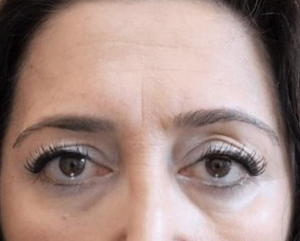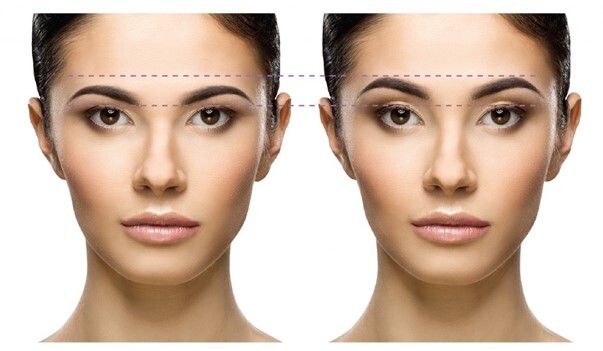Brow lift
A brow lift is a cosmetic procedure to raise the brows. It's also known as a forehead lift or forehead rejuvenation. A brow lift improves the appearance of the forehead, the brow and the area around the eyes. The procedure involves raising the soft tissue and skin of the forehead and brow.
You might choose to have a brow lift if you have a low, sagging brow or uneven brows. A brow lift might also boost your self-confidence. A brow lift is a permanent procedure, but light wrinkles may return over time.
A brow lift can be done alone or with other facial procedures, such as eyelid surgery (blepharoplasty) or a face lift.
You might choose to have a brow lift if you have a low, sagging brow or uneven brows. A brow lift might also boost your self-confidence. A brow lift is a permanent procedure, but light wrinkles may return over time.
A brow lift can be done alone or with other facial procedures, such as eyelid surgery (blepharoplasty) or a face lift.


A brow lift is a cosmetic surgical procedure that repositions your forehead to raise the brow, reduce wrinkles and give you a more youthful appearance.
As you age, your skin loses elasticity. The accumulated effect of sun damage weakens skin and gravity pulls your brow down, which causes wrinkles. On your forehead, you may have “frown lines” between your eyebrows that make you look serious or angry. You may also develop horizontal lines. The outside of your brow may sag, which makes you look sad or tired because of drooping eyebrows. If you’re looking to correct these natural changes to your body, a brow lift might be right for you.
As you age, your skin loses elasticity. The accumulated effect of sun damage weakens skin and gravity pulls your brow down, which causes wrinkles. On your forehead, you may have “frown lines” between your eyebrows that make you look serious or angry. You may also develop horizontal lines. The outside of your brow may sag, which makes you look sad or tired because of drooping eyebrows. If you’re looking to correct these natural changes to your body, a brow lift might be right for you.
Is there a nonsurgical brow lift?
1.A nonsurgical brow lift procedure uses botulinum toxin injections to smooth out wrinkles on your forehead. Non Surgical brow lift options are available if you want to improve your appearance, but prefer to avoid surgery, long recovery times and scarring. For the procedure, your dermatologist will inject the medicine in between your eyebrows and at the corners of your eyebrows.A brow lift such as this offers some of the same benefits as a surgical brow lift, including:
● Reduces wrinkles.
● Elevates the height of your eyebrows.
● Reshapes your eyebrows.
● Makes you look younger.
However, these injections aren’t permanent and you’ll need repeat treatments several times a year to keep your results.
2.A thread brow lift is a minimally invasive type of facelift surgery to tighten your skin. This procedure uses thin and dissolvable barbed stitches (threads) underneath your skin to pull your skin back and tighten it. Your body reacts to the threads and increases your body’s production of collagen. Collagen is a protein that gives your skin strength and support to fill in wrinkles. A thread brow lift is done on your forehead to reduce existing wrinkles.


Aging typically causes the brows to move down. Skin and soft tissues lose the ability to snap back into place after being stretched. This causes the distance between the eyebrows and eyelashes to shorten.
The lower position of the eyebrows can make you look tired, angry or sad. A brow lift can raise the eyebrows and may provide a refreshed appearance.
You might consider a brow lift if you have a low or sagging brow that's contributing to sagging upper eyelids.
The lower position of the eyebrows can make you look tired, angry or sad. A brow lift can raise the eyebrows and may provide a refreshed appearance.
You might consider a brow lift if you have a low or sagging brow that's contributing to sagging upper eyelids.

Before
Brow lift
Brow lift risks
A brow lift poses several risks, including:● Scarring: Scarring might be visible after a brow lift.
● Changes in skin sensation: A brow lift can cause temporary or permanent numbness on the forehead or top of the scalp.
● Asymmetry in the position of the brows: A brow lift can result in uneven brows (asymmetry), with one or both eyebrows appearing too high. However, asymmetry may even out during the healing process. Persistent brow shape or position problems can be treated with injections such as Botox or through additional surgery.
● Hair problems: A brow lift can cause an elevated hairline or hair loss at the incision site. If hair loss doesn't resolve on its own, it can be treated with a procedure to remove part of the scalp experiencing hair loss or using a hair graft.
● Like any other type of major surgery, a brow lift poses a risk of bleeding, infection and a reaction to anesthesia.

How you prepare for brow lift
Initially, you'll talk to a facial plastic surgeon or dermatologist about a brow lift. During your first visit, your surgeon will likely:Review your medical history. Be prepared to answer questions about current and past medical conditions. Talk about any medications you're taking or have taken recently, as well as any surgeries you've had. Tell your surgeon if you're allergic to any medications.
Do a physical exam. To determine your treatment options, your surgeon will examine and measure different parts of your face with your eyes open and closed. Photographs might be taken for your medical record.
Discuss your expectations. Explain why you want a brow lift, and how you want to look after the procedure. Make sure you understand the benefits and risks.
Before a brow lift you might also need to:
● Stop smoking. Smoking decreases blood flow in the skin and can slow the healing process. If you smoke, stop smoking before surgery and during recovery.
● Avoid certain medications. You'll likely need to avoid taking aspirin, anti-inflammatory drugs and herbal supplements, which can increase bleeding.
● Arrange for help during recovery. Make plans for someone to drive you home after you leave the hospital or surgical center and stay with you for at least the first night of your recovery at home.


What you can expect
A brow lift is done in a hospital or an outpatient surgical center. During a brow lift, you'll typically be comfortable with the aid of sedation anesthesia given through an IV in your arm. Or you may be given general anesthesia.

During the brow lift procedure
Brow lift techniques vary depending on your desired results. The specific technique your surgeon chooses will determine the location of the incisions and the resulting scars.Your surgeon might use one of the following techniques
1.Direct brow lift. This surgery involves the placement of a single incision above the brow that is either hidden in the brow, forehead wrinkles, or behind the hairline. Several factors determine the surgical incision site, including the thickness of brows, depth of forehead furrows, and hairline. Through this technique, dermatologist accesses and releases the forehead muscles, then tightens and repositions them using self-dissolving sutures. Excess skin may be removed to help shorten the length of a tall forehead or to remove excess skin. Direct brow lifts are usually recommended for more mature patients who have significant skin laxity or patients with deep forehead lines. A direct brow lift surgery usually takes around 30-60 minutes under local and light sedation.


2.Endoscopic brow lift. In this procedure, several small incisions are made behind the hairline. A long thin tube with a light and a tiny camera mounted on its end is inserted through one of the incisions to view the underlying muscles and tissues. Using an instrument inserted through another incision, the surgeon lifts the forehead tissues and anchors them in place with sutures, small screws or another technique. The incisions are then closed with stitches or small clips.

3.Temporal brow lift. This procedure is done through small incisions just behind the hairline near the temples.

4.Coronal brow lift. This procedure involves making an incision behind the hairline across the top of the head, from ear to ear or primarily on the top of the head. Then the forehead is lifted into its new position, with the scalp in front of the incision overlapping the scalp behind it. The overlapping scalp is then removed, and the remaining scalp is sewn together. This technique is not typically done in people who have high hairlines, thin hair or who are likely to lose their hair.

5.Hairline brow lift. For this procedure, an incision is made between the top of the forehead and the beginning of the hairline. A small amount of skin and tissue is removed from the top of the forehead, rather than your scalp. This can correct a high hairline. A hairline brow lift is often used if someone has a high, receding hairline. However, a scar might be visible along the hairline, depending on the placement of the incisions, scar healing and hairstyle.
Brow lift surgery typically takes about 1-2 hours.
Brow lift surgery typically takes about 1-2 hours.
After the procedure
After a brow lift, your forehead might be loosely wrapped to minimize swelling. A small tube might be placed along the incision site to drain any excess blood or fluid.Your health care provider will give you specific instructions on how to care for your incisions. In the first few days after a brow lift:
● Rest with your head elevated and take pain medication as recommended by your provider
● Apply cold compresses to relieve swelling
● Avoid exposing your incisions to excessive pressure or motion
● As your incisions heal, you might experience itching and numbness, which will likely lessen over time. If your incisions are covered in bandages, they'll likely be removed in 1-3 days. Sutures typically will be removed within 7-10 days of surgery.
● Ask your health care provider when it's OK to resume daily activities, such as washing and drying your hair and bathing. Keep in mind that the swelling might last several weeks.
● Incision lines will fade over time. You might use makeup to conceal any prolonged bruising.


After a brow lift, contact your doctor immediately if you have :
● Sudden swelling
● Shortness of breath
● Chest pain
● Irregular heartbeats
● Sudden swelling
● Shortness of breath
● Chest pain
● Irregular heartbeats
Results :
By raising the soft tissue and skin of your forehead and brow, a brow lift can give your face a more youthful appearance.
Keep in mind that brow lift results won't last forever. As you age your facial skin might begin to droop again. Sun damage also can age your skin.
By raising the soft tissue and skin of your forehead and brow, a brow lift can give your face a more youthful appearance.
Keep in mind that brow lift results won't last forever. As you age your facial skin might begin to droop again. Sun damage also can age your skin.










